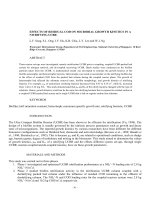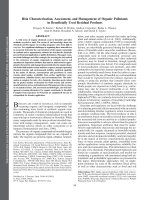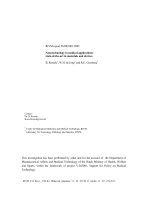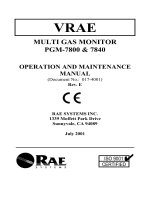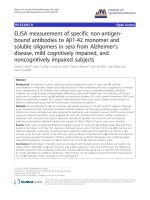materials forum measurement of residual stresses in joints
Bạn đang xem bản rút gọn của tài liệu. Xem và tải ngay bản đầy đủ của tài liệu tại đây (449.18 KB, 9 trang )
MATERIALS FORUM VOLUME 30 - 2006
Edited by R. Wuhrer and M. Cortie
© Institute of Materials Engineering Australasia Ltd
MEASUREMENT OF RESIDUAL STRESS DISTRIBUTION IN TUBULAR
JOINTS CONSIDERING POST WELD HEAT TREATMENT
A. Paradowska, J.W.H. Price, P. Dayawansa
1
, B. Kerezsi
1
, X-L. Zhao
2
and R. Ibrahim
Monash University, Department of Mechanical Engineering,
1
Monash University, Maintenance Technology Institute,
2
Monash University, Department of Civil Engineering,
PO Box 197, , Clayton, Victoria 3800 Australia
ABSTRACT
One of the most important connections in tubular structures is the welded joints called clusters or nodes. These connections
are subject to the highest stresses and fatigue loadings and thus are the most probable position of cracking. In this work
research has been conducted to determine the benefit of post weld heat treatment (“PWHT”) of connections to improve
fatigue life of these clusters.
This paper describes investigations conducted on residual stress measurements using hole-drilling techniques in tubular
boom clusters. Residual stress and other material characteristics were measured before and after heat treatment and the
results used related to the fatigue performance of the connections with and without PWHT. The results indicate that PWHT
could be a major contributor to improved performance.
Keywords: Welding, Clusters, Nodes, Hole Drilling, Residual Stress, Fatigue, Tubular Structures
1. INTRODUCTION
Tubular structures are used for large civil structures such
as bridges, offshore structures and materials handling
machinery. Perhaps the most demanding of these in
regard to integrity, is the boom of large mining draglines,
where the structure is swung from side to side under high
accelerations and loadings approximately once every
minute, resulting in about 500,000 fatigue cycles per year.
In these booms, fatigue cracking commonly occurs at the
overlapping connections of the main chords and the
lacings. The cost of detecting and repairing cracking in
these structures is a significant cost item for the mining
industry
1
.
The cause of cracking is complex. Normally stress
concentrations arise around flaws/defects such as slag
inclusions or incomplete fusion in welds and this is often
implicated in cracking. For predicting fatigue life of
weldments, previous investigations have developed
experimental methods to determine the fatigue behavior of
weld structures at locations of defects
2
and at weld toes
3
.
Residual stresses, which arise in the welded joints as a
consequence of strains caused by solidification, phase
change and contraction during welding, also affect the
fatigue behavior of welds. In particular, tensile residual
stress of yield magnitude may exist in as-welded structures
and may cause detrimental effects to the fatigue behavior
of welded structures.
For estimating total life, the normal approach to fatigue
analysis of welded structural components is based on
the S–N curve based on full scale testing of specific
welded details which presumably contain residual
stresses and minor flaws. This appears in codes such as
BS5400
4
. Fitness for purpose can be assessed using
fracture mechanics codes such as BS7910
5
. In that
code, residual stress without PWHT should be taken to
be the yield stress, but a lower residual stress of 30%
yield may be assumed after PWHT
Residual stresses in weld joints can be reduced by heat
treatment
6
or by mechanical stress relieving
7
. PWHT is
often referred to as a stress relieving process since it is
assumed that residual stresses are reduced by heating
the component to 550-650
o
C for a period of time
depending upon plate thickness, followed by uniform
cooling. PWHT is also very helpful because it softens
or tempers any hard martensite or bainite that has
formed in the heat affected zone (HAZ). However,
PWHT does not always have a positive effect and can
cause distortion and degradation of the microstructure.
Stress relieving heat treatments are generally avoided
unless specified as mandatory by Codes and/or
Standards, because of the high cost involved and
potential adverse consequence of incorrect PWHT
procedure. PWHT is not required on clusters on mining
booms (though PWHT is used on butt to butt welds in
30
the chords) and is often not performed on other civil
structures.
There are many methods of residual stress measurements
with varying levels of sophistication and complexity
8,9
.
Using neutron beams to measure the deformations in the
material crystal structures is one possibility
10
. Neutron
beam measurements can quantify residual stresses not
only on the surface but also through the thickness of the
material. However, these methods are expensive and have
limitations of application due to the size of the equipment
used (e.g. access to restrictive geometric locations is
difficult). One of the most simple but effective techniques
involves using semi-destructive techniques
11
such as the
conventional hole drilling technique (“HD“)
12
and ring-
core method (trepanning technique), (“TT“))
13
.
This paper describes the investigations conducted on
microstructure, hardness, tensile tests and residual stress
measurements in a mining boom cluster before and after
PWHT. Experience with the use of incremental hole
drilling technique for residual stresses measurements in
the clusters is described. The results are considered in
relation to the fatigue performance of the connections with
and without PWHT.
2. EXPERIMENTAL PROCEDURE
2.1 Material Properties
The cluster design involved is an overlapped multi-
planar K-K- tubular welded connection (Figure 1),
consisting of 406 mm (16’’) , 19 mm thick main chord
and four lacing members of 168 and 219 mm (6’’ and
8’’) OD and 8 mm thickness. The parent material for
this construction is carbon steel, the typical chemical
composition of this material and the weld metal are
shown in Table 1. The typical mechanical properties of
the parent metal for a main chord and lacings are shown
in Table 2. The typical microstructures for the parent
material, HAZ and weld metal after PWHT are shown
in Figure 2. Note that these show no noticeable
variation to the observations of microstructure that have
been made on this and other clusters prior to PWHT.
After the root bead, the welding on these clusters is
performed by the weaving technique. The welds
conform to AWS D1.1
14
.
Table 1. Typical chemical composition of weld and parent material
%
Material
C Si Mn P S Ni Cr Mo Cu V Ti Co
Parent
.19 .22 .96 .01 .02 .08 .10 .03 .07 .08 .01 .01
Weld
.07 .46 1.5 .02 .01 .04 .03 .31 .15 .01 .01 .01
Spec API 5L
60X max
.24 1.4 .025 .015 Nb+V+Ti <
.15
Table 2. Typical mechanical properties obtained experimentally
Mechanical properties
Yield Stress
[MPa]
Tensile
Strength [MPa]
Elongation
[%]
Before PWHT 330 519 32
Parent metal - main cord
After PWHT 320 506 33
Before PWHT 298 463 33
Parent metal - lacing
After PWHT 264 440 30
31
Lacings
Main chord
Figure 1. A cluster BE39
Weld
100 µm
Parent metal
100 µm
HAZ
100 µm
Parent metal
HAZ
1 mm
Weld
Figure 2. Optical micrographs through welded section after PWHT (B39): parent metal (ferrite & pearlite), in HAZ
(predominantly bainite), weld metal (martensite& bainite).
32
2.2. Post Weld Heat Treatment (PWHT).
The stress relieving procedure was based on the
requirements of AWS D1.1 and a proprietary procedure
developed by the heat treatment company for the post
weld heat treatment of pipe butt welds. The procedure
involved uniformly heating the cluster up to 600°C,
holding for a period of 1 hour and cooling back to room
temperature.
Figure 3 shows a picture of the cluster during the
laboratory trials and Figure 4 shows the results from the
thermocouple measurements of the cluster during the
trial.
Measurements of the movement of the lacing
members using dial gauges during the procedure
showed a maximum variation of 0.6-0.7 mm between
members.
Figure 3. Cluster with heating pads and insulation fitted
ready for heat treatment
Figure 4. Thermocouple readings taken during the
laboratory trial.
100
150
200
250
300
350
400
-40-2002040
Distance from the center of the weld (mm)
Hardness (HV)
Before PWHT
After PWHT
Lacings
Main cord
Weld
Figure 5. Comparison of the results hardness measurements (using EQUITIP) before and after post weld heat treatment
(PWHT)
33
2.3 Weld hardness profile
2.3.1 Non destructive hardness measurements
Hardness measurements were taken on the surface of the
cluster using non-destructive technique. An EQUITIP set-
up (accuracy ± 6 LD) was used. The area of the
measurement was polished and cleaned with alcohol.
Direct measurements in (LD) scale were then converted to
Vickers scale (HV) and the result shown in Figure 5.
These measurements were taken before and after PWHT
to establish the influence of heat treatment on the hardness
of the weldment.
2.3.2. Vickers measurements after PWHT on cut
cross sections.
Hardness profiles were measured using a 5 kg
indentation load on a cross section of parent metal taken
from the main cord after PWHT. The line scans (Figure
6a) were taken according to the Australian standard for
hardness assessment of weldments
15
, three impressions
in the weld and then every 0.5 mm through the HAZ
and the PM. Result are shown in Figure 6b. This
information was obtained to establish the hardness of
the weld bead and the HAZ.
100
150
200
250
300
0123456
Position (mm)
Vickers Hardness
(
HV
)
Line 1
Line 2
Line 3
Line 4
a
)
b
)
Weld metal
Figure 6 a) Schematic illustration of Vickers Hardness measurements, b) comparison of the results of hardness
measurements for line scans.
3. RESIDUAL STRESS EVALUATION
The hole drilling method is often described as “semi-
destructive” because the damage that it causes is localized
and in many cases does not significantly affect the
usefulness of the specimen. The hole drilling method
involves the application of a special three-element strain
gage rosette (as shown in Figure 7) onto the surface of the
component at the measurement location. A small hole (1-
2 mm diameter) is then made into the component through
the centre of the rosette. The production of the hole in the
stressed component causes a redistribution of strains to
occur near the hole, which can be detected and measured
by the surface mounted strain gauge rosette. The
measured relieved strains due to the hole production are
then related to the original surface residual stress.
A high speed air turbine assembly (Figure 8) was used for
the hole drilling and measurement were taken using strain
indicator P-3500 from strain gages type EA13062RE120
with characteristic parameters: resistance = 120 ± 0.2
Ohms, and gauge factor = 2.08 ± 0.01.
The measurements were performed on the cluster
according to the method described in ASTM Standard
E837
16.
. Incremental readings were taken at steps of 0.5
mm. The location of the measurements before and after
PWHT is shown on Figure 9.
The residual stresses were derived using Equation 1
with Young’s modulus taken to be 207 GPa, and
Poisson’s ratio 0.3.
Main cord
WM PM
HAZ
Lacings
1
2
4
3
4
34
()( )
b
2E
1
B
a
2E
ν1
A
B4
2εεεεε
A4
εε
σ,σ
213
2
13
13
minmax
⋅−=
⋅
+
−=
−++−
±
−
=
Equation 1
Where
, are the principal stresses
max
σ
min
σ B,A are
calibration constants; and
b,a
are material independent
coefficients. ε
1
and ε
3
are hoop and axial strain and ε
2
is at
45° to these axes (See Figure 7).
4. RESULTS
4.1 Residual stress
The residual stress measurements taken using the hole
drilling technique (HD) are shown in Table 3 before
PWHT and in Table 4 after PWHT.
Axial
Hoop
Figure 7. Strain gauges geometry and position according
to the direction of stress
Figure 8. Hole-drilling measurements on B39 cluster
35
Figure 9. Approximate location of the hole drilling measurements.
Table 3. The residual stress measurements using HD before PWHT
Stress (MPa) Gauge
No.
Location of the strain gauge
θ an
g
le to the
σ
max
σ
max
σ
min
1
the reference point 880 mm from the cluster centre
line
-84 50 7
2
the centre of the hole 12 mm from the toe of the weld 2 159 66
3
the centre of the hole 10 mm from the toe of the weld -13 156 62
Table 4. The residual stress measurements using HD after PWHT
Stress (MPa) Gauge
No.
Location of the strain gauge
θ angle to the
σ
max
σ
max
σ
min
1’ the reference point 720 mm from the cluster centre line 63 56 -58
2’ the centre of the hole 12 mm from the toe of the weld -72 99 -35
3’ the centre of the hole 10 mm from the toe end of the weld -76 108 -25
4’ the centre of the hole 12 mm from the toe of the weld -23 33 7
5’ the centre of the hole 12 mm from the toe end of the weld -23 47 20
6’ the reference point 720 mm from the cluster centre line 30 20 -41
Region not
heat treated
x - HD measurements before PWHT
x’ - HD measurements after PWHT
Region not
heat treated
Heat treated region
x4’
x
1’
x6‘
x5’
x2
x3
H
A
x1’
x2’
x3’
Datu
m
36
5. DISCUSSION
5.1 Material properties
Microstructure does not change significantly after PWHT
(Figure 2). The Yield strength was reduced by 3% for the
main chord and 11% for the lacings, however it still
complies with the specifications.
Surface portable non-destructive hardness measurements
(Figure 5) and Vickers hardness measurements (Figure 6b)
are in good agreement. After PWHT softening in the
parent metal (5%) and in the weld (up to 25%) has been
observed (Figure 5).
It is to be noted that the high hardness on the surface of
the weld before PWHT indicates quite severe cooling
conditions in the last bead. The hardness permitted under
the Australian Standard for Structural Steel Welding is a
maximum of 350 HV 10 in the heat affected zone and
weld metal may not exceed parent metal by more than 100
HV 10
17
. This weld does not conform to either of these
requirements. Having said this it is to be noted that the
hardness tests are not normally conducted on the surface
of the weld (though this possibility is not specifically
excluded in the standard).
The results from four line scans (Figure 6b) show that the
hardness in the HAZ after PWHT does not exceed 250
HV. The root scans (2 and 3) are slightly lower in the
weld than the toes scans (1 and 4). This can be explained
by rapid cooling in the last weld bead, particularly for scan
4. Using understanding gained in work on neutron beam
measurement of multi-bead welds
18
it is probable these
results can be explained by rapid cooling of the last metal
to solidify.
5.2 Residual stress and extension of fatigue life.
The welded construction of the cluster is highly restrained
and is rapidly cooled. This means that the weld is likely to
have high residual stresses before heat treatment.
Measurements of residual stress were taken close to the
welded region for the main chord before (Table 3) and
after (Table 4) the heat treatment procedure. The
measurements verify that stress levels in the axial
direction were reduced by approximately 40% while
tensile stresses in the hoop direction were removed or
made compressive.
Reduction in residual stress is believed to help prolong the
fatigue life of the structure, since high tensile surface
residual stress levels are known to contribute to crack
initiation and propagation. In reference
1
evidence of this
is presented based the fatigue analysis program NASGRO.
For the clusters in question fatigue life may be extended
from a few years to over 20 years.
6. CONCLUSIONS
This paper investigates the possibilities of using post
weld heat treatment (“PWHT”) for reducing residual
stress and hardness and thus improving the fatigue life
of welded tubular structures. The paper uses a number
of non-destructive and semi-destructive techniques to
follow the changes in properties during PWHT.
Key findings are that:-
(a) Axial residual stresses up to 50 MPa were
observed in the seamless cluster chord 880 mm
away from any welding. These are presumably
stresses left over from original manufacture of the
chord.
(b) Residual stresses of 158 MPa were observed 12
mm from the weld prior to PWHT. This is
approximately 50% of the yield stress of the
material.
(c) Hole drilling is actually not very good at
measuring the detail of residual stresses where
there is a rapidly changing stress field. The
gauges used in the hole drilling technique (Figure
7) prevent the hole being placed closer than about
10 mm to the weld. From neutron beam
measurements it is known that the tensile residual
stress actually in the HAZ next to the weld can
exceed yield and that the stress rises rapidly in
the last 5 mm [10 and 18]. This indicates the
limitations of the use of the hole drilling
technique in regions of fast changing residual
stress and what corrections need to be made when
no alternative to hole drilling exists
(d) Stress relieving can significantly reduce (~40%)
axial tensile residual stresses around the cluster
while tensile stresses in the hoop direction were
reduced or made compressive.
(e) High hardness measurements were observed on
the surface of the weld metal prior to PWHT.
The location of these high hardness
measurements conforms to the position of the last
bead to solidify. These hardness measurements
exceeded the permitted values in the Standard.
Arguably, the weld nevertheless may conform to
the standard since methods were used to measure
hardness that are not normally used in the
standard procedures.
(f) After PWHT, hardness was reduced to levels
acceptable in the standards.
(g) Reduction in the values of residual stress and
hardness which occur during PWHT are likely to
improve the service life of the cluster
37
Acknowledgements
This paper is a brief report taken from a larger research
project which is currently in progress at Monash
University. Supporters for the work have included the
Australian Coal Association Research Program
(“ACARP”), Australian Research Council (“ARC”),
Welding Technology Institute of Australia (“WTIA”).
References
1 Dayawansa P., Kerezsi B., Chitty G., Price J.W.H.
and Bartoseiwicz H., Chronic Problem Areas, Repair
Quality and Improved Repairs for Dragline
Structurals, Australian Coal Association Research
Program ACARP: C11052, 2003, 150 Pages.
2 Chiarelli M. Lanciotti A. and Sacchi M., Int. J. of
Fatigue, 1999, 21(10), pp. 1099-1110.
3 Martins Ferreira J.A. and Moura Branco C.A., Int. J.
Fatigue, 1989, 11(1), pp.929–36.
4 British Standards, Specification for steel, concrete and
composite bridges, Code of practice for fatigue, BS
5400, BSI, London, 1980.
5 British Standards, Guide on Methods for Assessing
the Acceptability of Flaws in Fusion Welded
Structures. BS 7910:1999, BSI, London, 2000.
6 Sedek P., Brozda J, Wang L. and Withers P.J., Int. J.
of Pressure Vessels and Piping, 2003, 80, pp. 705-
713.
7 Cheng X., Fisher, J.W., Prask, H.J., Gnäupel-Herold,
T., Yen, B.T. and Roy, S., Int. J. of Fatigue, 2003, 25,
pp. 1259-1269.
8 Withers, P.J. and Bhadeshia H.K., Materials
Science and Technology, 2001,17, pp. 355-365.
9 Bahadur, A., Kumar, B.R., Kumar, A.S., Sarkar,
G.G., and Rao, J.S., Materials Science and
Technology, 2004, 20, pp. 261-269.
10 Price J.W.H., Paradowska A., Finlayson T.,
Proceedings of PVP2005, ASME Pressure Vessels
and Piping Division, Denver, Colorado USA, July
17-21, 2005
11 Niku-Lari A., Advances in Surfaces Treatments –
Residual Stresses,1988, 4, pp. 165-198
12 George D.; Kingston E. and Smith D.J., J. of Strain
Analysis for Engineering Design, 2002, 37(2), pp.
125-139.
13
Andersen L.F., J of Engineering Materials and
Technology, 2002, 124(4), pp. 428-433.
14 American Welding Society, Structural Welding
Code- Steel, D1.1:2000, AWS, Miami, Florida,
2000.
15 AS 2205.6.1-2003, Methods for destructive testing of
welds in metal - Weld joint hardness test, Standards
Australia, Sydney, 2003.
16 American Society for Testing of Materials,
Standard Test Method for determining Residual
Stresses by the Hole drilling Strain – Gage Method.
ASTM E 837-99, 2003.
17 Australian/NewZealand Standard, Structural Steel
Welding, ASA/NZS 1554.1:2000, Standards
Australia, Sydney, Sections 4.7.8 and 4.7.9, 2000.
18 Paradowska, A., Price, J.W.H., Ibrahim, R.,
Finlayson, T., J. of Materials Processing
Technology, 2005, vol 164-165, pp 1099-1105.
38

